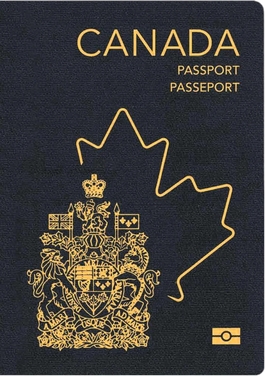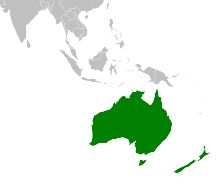
A visa is a conditional authorization granted by a polity to a foreigner that allows them to enter, remain within, or leave its territory. Visas typically include limits on the duration of the foreigner's stay, areas within the country they may enter, the dates they may enter, the number of permitted visits, or if the individual can work in the country in question. Visas are associated with the request for permission to enter a territory and thus are, in most countries, distinct from actual formal permission for an alien to enter and remain in the country. In each instance, a visa is subject to entry permission by an immigration official at the time of actual entry and can be revoked at any time. Visa evidence most commonly takes the form of a sticker endorsed in the applicant's passport or other travel document but may also exist electronically. Some countries no longer issue physical visa evidence, instead recording details only in immigration databases.
Australian permanent residents are residents of Australia who hold a permanent visa but are not citizens of Australia. A holder of a permanent visa may remain in Australia indefinitely. A 5-year initial travel facility, which corresponds to the underlying migration program, is granted alongside the permanent visa. Until the travel facility expires, the visa holder may leave and re-enter Australia freely. After that period the visa holder needs to re-apply for the travel facility. However, holders of a permanent visa who are already in Australia with an expired travel facility may remain in Australia indefinitely.
Permanent residency is a person's legal resident status in a country or territory of which such person is not a citizen but where they have the right to reside on a permanent basis. This is usually for a permanent period; a person with such legal status is known as a permanent resident.

Foreign relations between neighbouring countries Australia and New Zealand, also referred to as Trans-Tasman relations, are extremely close. Both countries share a British colonial heritage as antipodean Dominions and settler colonies, and both are part of the core Anglosphere. New Zealand sent representatives to the constitutional conventions which led to the uniting of the six Australian colonies but opted not to join. In the Boer War and in both world wars, New Zealand soldiers fought alongside Australian soldiers. In recent years the Closer Economic Relations free trade agreement and its predecessors have inspired ever-converging economic integration. Despite some shared similarities, the cultures of Australia and New Zealand also have their own sets of differences and there are sometimes differences of opinion which some have declared as symptomatic of sibling rivalry. This often centres upon sports and in commercio-economic tensions, such as those arising from the failure of Ansett Australia and those engendered by the formerly long-standing Australian ban on New Zealand apple imports.
In law, an alien is generally any person who is not a citizen or a national of a specific country, although definitions and terminology differ across legal systems.
The right of abode is an individual's freedom from immigration control in a particular country. A person who has the right of abode in a country does not need permission from the government to enter the country and can live and work there without restriction, and is immune from removal and deportation.

The permanent resident card also known colloquially as the PR card or the Maple Leaf card, is an identification document and a travel document that shows that a person has permanent residency in Canada. It is one of the methods by which Canadian permanent residents can prove their permanent residency status in Canada, and is one of the only documents that allow permanent residents to return to Canada by a commercial carrier.
A Special Category Visa (SCV) is an Australian visa category granted to most New Zealand citizens on arrival in Australia, enabling them to visit, study, stay and work in Australia indefinitely under the Trans-Tasman Travel Arrangement. Currently, there are two categories of SCVs: protected SCV and as non-protected SCV. New Zealanders who had entered Australia before 26 February 2001 are classified as protected SCV holders, and after that date as non-protected SCV holders. The rights of the two categories are somewhat different.

A Canadian passport is the passport issued to citizens of Canada. It enables the bearer to enter or re-enter Canada freely; travel to and from other countries in accordance with visa requirements; facilitates the process of securing assistance from Canadian consular officials abroad, if necessary; and requests protection for the bearer while abroad.

The visa policy of Australia deals with the requirements that a foreign national wishing to enter Australia must meet to obtain a visa, which is a permit to travel, to enter and remain in the country. A visa may also entitle the visa holder to other privileges, such as a right to work, study, etc. and may be subject to conditions.
A Permanent Resident of Norfolk Island visa was a type of Australian immigration visa granted on arrival in Australia to a non-citizen who is a permanent resident of Norfolk Island.

Visitors to the United States must obtain a visa from one of the U.S. diplomatic missions unless they are citizens of one of the visa-exempt or Visa Waiver Program countries.

The visa policy of Canada requires that any foreign citizen wishing to enter Canada must obtain a temporary resident visa from one of the Canadian diplomatic missions unless they hold a passport issued by one of the 53 eligible visa-exempt countries and territories or proof of permanent residence in Canada or the United States.
New Zealand Permanent Residents are residents of New Zealand, who hold a residence class visa. Both resident visas and permanent resident visas give the holders the permanent right to be in New Zealand. However, they have different travel conditions.

Visa requirements for Australian passport holders are administrative entry restrictions by the authorities of other states placed on citizens of Australia entering with an Australian passport.

Visa requirements for South African citizens are administrative entry restrictions by the authorities of other states placed on citizens of the Republic of South Africa.
Visa requirements for New Zealand citizens are administrative entry restrictions by the authorities of other states placed on citizens of New Zealand.
The visa policy of the Philippines is governed by Commonwealth Act No. 613, also known as the Philippine Immigration Act, and by subsequent legislation amending it.

Non–New Zealand citizens wishing to enter the Realm of New Zealand must obtain a visa unless they are

New Zealand Australians refers to Australian citizens whose origins are in New Zealand, as well as New Zealand migrants and expatriates based in Australia. Migration from New Zealand to Australia is a common phenomenon, given Australia's proximity to New Zealand, its larger economy, free movement agreement and cultural links between the two countries.












